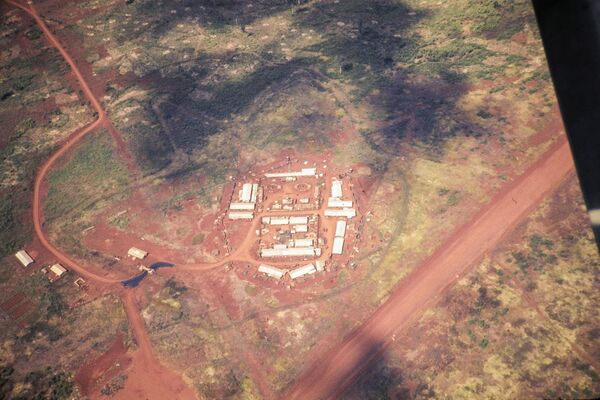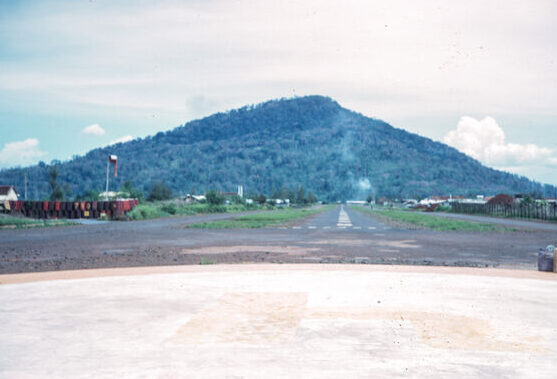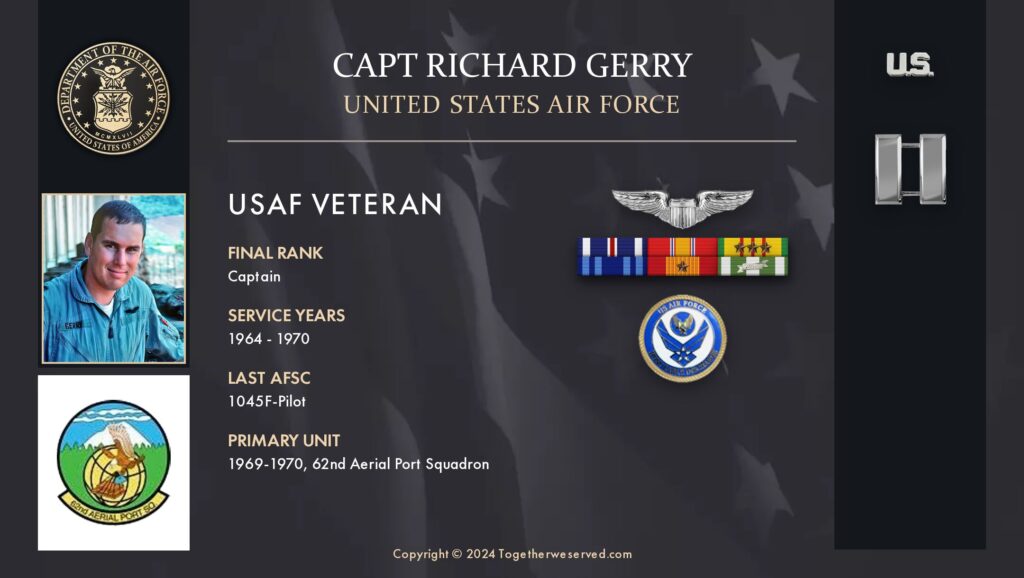PRESERVING A MILITARY LEGACY FOR FUTURE GENERATIONS
The following Reflection represents Capt Richard Gerry’s legacy of their military service from 1964 to 1970. If you are a Veteran, consider preserving a record of your own military service, including your memories and photographs, on Togetherweserved.com (TWS), the leading archive of living military history. The Service Reflections is an easy-to-complete self-interview, located on your TWS Military Service Page, which enables you to remember key people and events from your military service and the impact they made on your life.
Has Together We Served helped you find and reconnect with someone you served with? If so, please describe how this happened and what this meant to you. Please add any specific memories of this person and a photo if available.:
This is my response to my friend Robert Pryor’s post.
Friday, June 20th, 1969, is a day I’ll never forget! In two weeks, I would be on that Freedom Bird heading home.
I was Air Force Captain Dick Gerry, the Air Liaison Officer (ALO) and Forward Air Controller (FAC) at Song Be, Phuoc Long Province, assigned to MACV Advisory Team 67. I flew the O-1 Bird Dog, and my call sign was Rod 11. Approaching the end of my tour, I had more than five hundred combat missions under my belt.
We had three airplanes and up to five FACs stationed there and did all our flying out of the Song Be City airstrip, which was very narrow and not very long.
On Wednesday, June 18th, I flew one of our airplanes to Bien Hoa for scheduled maintenance. While there, final arrangements were made for my departure from the War Zone. The next day, the 19th, after a few hiccups in getting my airplane released, I returned to Song Be just before dark. One general rule was not to fly the O-1 at night alone. The instruments were basic and not conducive to night or inclement weather flying.
Tired from a long day, I briefly reviewed the next day’s schedule and noted that it should be relatively light. Then, at about 2100 hours, I went to bed.
It seemed as if I had just fallen asleep. Still, at 0215 hours on Friday, the intel sergeant from the Tactical Operation Center (TOC) woke me up and said that Camp Bunard, one of our Special Forces camps, A-344, was under immediate threat of being overrun. I quickly donned my combat flight gear and woke Sergeant Dave Gauntlett, our Radio Operator (RO). I explained to him what was happening and told him to request immediate support for every air asset he could find and send them to Bunard’s coordinates. No other FACs were available to help.
Then I woke our crew chief, A1C James Clamp, and we drove our Air Force Jeep to the flight line, which was less than two minutes away. I immediately went to the same Bird Dog I brought back from Bien Hoa. I knew its condition—fresh out of maintenance. There was no time to find another pilot to go with me, even if it was night. Bunard was in trouble.
At 0250, I took off, and within fifteen minutes, I was nearing Bunard. Already in radio contact with one of our Americans in the camp, it was hard to understand him due to the firefight going on around him. A couple of times, it sounded like he was simultaneously firing his rifle while talking to me. Still, he sounded calm under fire, which amazed me when he said only four American soldiers were there, along with the South Vietnamese equivalents. Complicating the situation was the estimate that at least one hundred or more VCs were breaching the outer perimeter and were basically invisible due to the darkness.
There’s no room here to go into detail. Still, my radio contact on the ground, Sergeant Carl Cramer, gave me the information I needed while I was simultaneously coordinating with a flight of two F-100 fighters, whose call sign was Hawk 01. Thanks to RO Sergeant Gauntlett back at Song Be, they were diverted from a pre-planned mission and showed up at the most critical time. When Cramer somehow connected with another member of the Bunard team, whose name, I discovered later, was 1st Lt John Parda. He launched a flare; I didn’t like what I saw. The VC were so close to whom I believed to be one of our soldiers who appeared to be outside the wire. I had to make a decision. With no time to second-guess, I explained to Hawk 01 where they had to place their bombs and the risk of hitting our man as the distance from the enemy troops could be measured in meters. I had no idea, then, that the soldier in question was Sergeant Pryor.


I also broke one of our flying rules as a FAC at that time: Never go below fifteen hundred feet above the terrain. I don’t know how low I went, but I did what I had to do. My marker was exactly where it was supposed to be, and Hawk 01 performed flawlessly. I thought we blew it, but he was still there, apparently wounded but not from the bombing.
I can’t recall perfectly, but it seems like Hawk 01 had some ordnance left over, and there was an area close to the chopper pad from where Charlie appeared to be launching their mortars. For the next six or seven hours, I coordinated with three Spookys, three Light Fire Teams, and more so the dust-off chopper could pick up our wounded and get him to the nearest hospital.
It may not seem like it from reading this, but that night and morning was the most chaotic TIC of my year in Vietnam. The assault did not let up. They kept coming in waves, and we kept repelling them. I think I finally landed back in Song Be for the last time, about 1030 hours.
The next day, I flew back to visit Bunard to see the aftermath of the day before. Losses were high on both sides. I spoke personally with Sgt Charles Hinson, whom I later discovered had risked his own life by going outside the wire and dragging the severely wounded Pryor back to relative safety. It didn’t look good for him.
I was in total awe that those Special Forces men, those Green Berets, never caved.
On the 4th of July 1969, I departed Bien Hoa for Travis AFB with no knowledge of the fate of that wounded soldier.
Many years later, in late 2022 or early 2023, I was reading a Vietnam War Stories blog called Cherries Writer. The title, “The Battle of Camp Bunard—1969,” caught my attention. As I read the story about Robert Pryor, his heroism, and his fight to survive, I texted John Podlaski, the Cherries Writer blogger. I asked if Robert was still alive and mentioned that I was the FAC who coordinated the air assets that morning. If he was alive, I asked John to have him contact me if he wished.
Not only have we become close friends, but we expect to meet in person this coming September. We knew it was a group effort when Robert thanked me for saving his life. But that didn’t stop me from breaking down and crying. And I don’t cry much.
PS: For some reason, I cannot post a couple of photos I wanted to add. Therefore, I ask Robert to do it for me, as he knows the ones I refer to. One is a photo of the Song Be airstrip, where I launched that night. It was 2200 feet long and 22 feet wide. The other is an aerial view of Bunard I took on January 8th, 1969, just a little over five months before the attack on Bunard.

Read the Military Memories of our Runner-Ups.
PRESERVE YOUR OWN SERVICE MEMORIES!
Boot Camp, Units, Combat Operations
Join Togetherweserved.com to Create a Legacy of Your Service
U.S. Marine Corps, U.S. Navy, U.S. Air Force, U.S. Army, U.S. Coast Guard

What can I add? Dick saved my life at least twice. I’m sure that thousands of lives were saved by the Forward Air Controllers. I am proud to call Dock my TWS brother, my Battle Buddy, and one amazing friend.